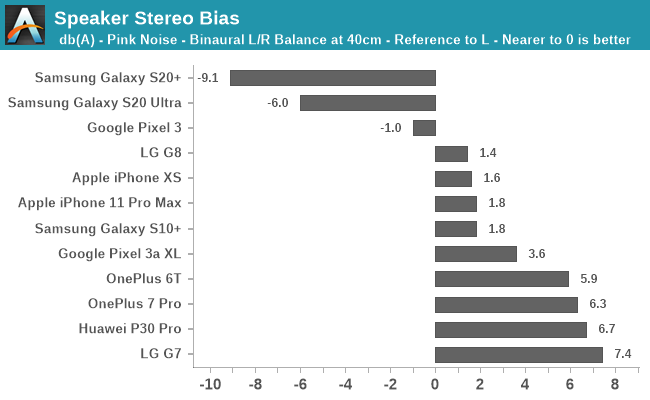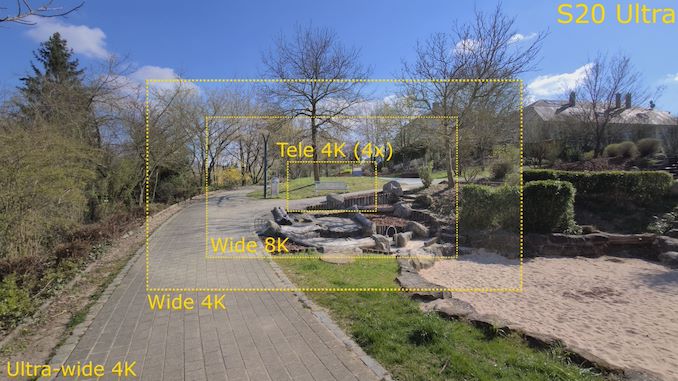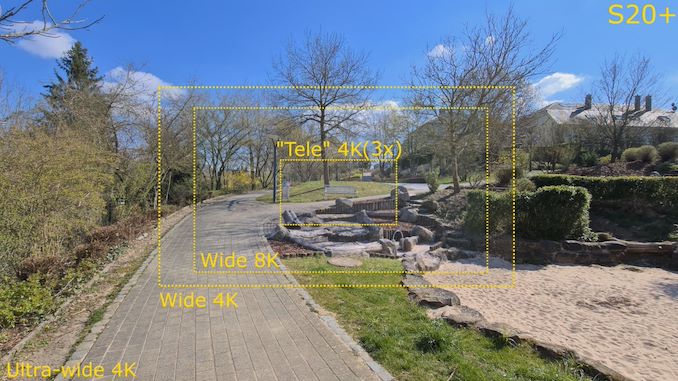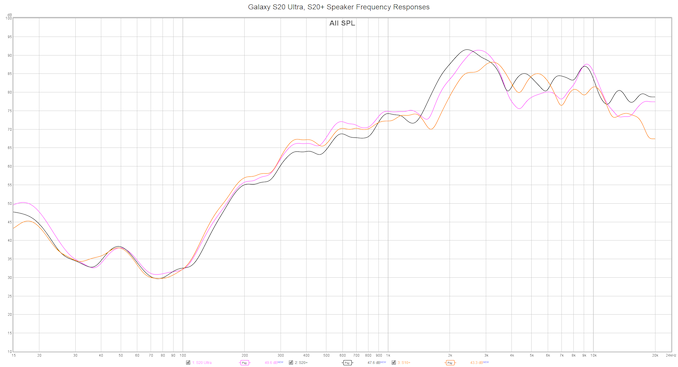The Samsung Galaxy S20+, S20 Ultra Exynos & Snapdragon Review: Megalomania Devices
by Andrei Frumusanu on April 3, 2020 9:30 AM ESTVideo Recording: Triple Cameras, 8K Recording?
Amongst the biggest hype features of the S20 series was their ability to capture 8K video. These are not only amongst the first mobile phones on the market to proclaim this capability, but they’re also amongst the first ever consumer cameras on the market, with the feature being previously just being available to professional equipment.
S20+ (E) S20 Ultra (E)
S20 Ultra (S)
Video quality on the phones on the main sensors and the usual 4K30 and 4K60 recording modes are excellent, with details and dynamic range being excellent. The above video samples this year remain in the default SDR recording profile, as Samsung HDR+ recording a “Labs” feature, and we saw it have quite the complication last year on the S10 series.
One thing I want to make note about the S20 Ultra is that a lot of people were complaining about focus issues of the camera, and I indeed also encountered that phenomenon, with some horrible results on the Snapdragon S20 Ultra (4K30 video sample). Fortunately, Samsung had already released a firmware update which fixed the issue on the Exynos model, and the sensor’s new PDAF system almost equally as fast as the dual-pixel PD of the Galaxy S20+.
A new video recording feature of the S20 series is the “Super Steady” mode. This mode is limited to FHD resolution and uses digital stabilisation to produce – well, a super steady video recording. The quality here however isn’t great, because what the phone is actually doing is cropping into a stabilised frame of the Ultra-Wide-Angle camera module, not being able to use the other camera modules at all even though the UI is a bit misleading in allowing you to switch between wide-angle and ultra-wide-angle perspectives.
Before going into the 8K samples, we have to talk a bit about how the phones actually achieve this. On the S20 Ultra, 8K recording obviously only is able to be done through the primary 108MP camera sensor as it’s the only unit with sufficient resolution to actually support it. The problem is, that the camera sensor isn’t able to super-sample the 8K video recording across the whole camera sensor, and instead uses a 1:1 crop of pixels of the sensor. Because the sensor’s native resolution is 12000 x 9000, it means it has to crop quite a bit to end up at the 8K video recording resolution of 7680 x 4320, resulting in a narrowed field-of-view, as you see in the above superimposed snapshots of the different video modes.
The S20+ on the other hand uses the secondary wide-angle module – again that’s simply because it’s the only module that is sufficiently high resolution to support the 8K resolution. Its native resolution here is only 9248 x 6936, meaning that it only has to crop a relatively smaller region of the sensor to fit in the 8K video frame. It means that the S20+ actually has a wider 8K field of view than the S20 Ultra, which I actually find to be much preferable for most use-cases.
The funny thing is that I have a hard time evaluating the video quality as currently I don’t even have any display in the house that’s able to natively display the full 8K video. If you’re lucky enough to have an 8K TV at home, I probably recommend casting the YouTube video to that device. For us mere mortals with 4K displays, all I can say is that the video looks absurdly sharp, and almost every frame of the video is almost the quality of a still camera capture.
Usually you’re used to digital cropping to be a mess, but even at up to 6x magnification within the video things still astoundingly good. I noted focusing is a bit slower on all the phones, and the S20+ really didn’t like switching over to close objects. Taking a few steps back did help the phone find its bearings.
Overall, the results are just outstanding, and I’m looking forward to what people will be able to achieve with help of professional video editing and camera work.
Speaker Evaluation
The speakers on the S20 series have undergone a rather drastic redesign, most of it due to the phone’s front camera design. Because the front camera is now at the centre of the display, Samsung was no longer able to house the earpiece speaker right next to the usual earpiece grill location. On the S20 series, the actual speaker is now located below the front camera, with an audio channel leading to a sliver thin gap between the display glass and the device’s frame. This fundamentally changes the audio characteristics of the phone, and it’s not all positive.

The biggest change is the fact that the new earpiece speaker is extremely loud, but also weirdly enough not very front directional. Holding the phone one-handed in portrait mode the phone doesn’t sound as loud as the S10+, but as soon as you hold it in landscape and use your palms as natural cups to focus the audio, the full brunt of the earpiece speaker is focused towards you. Interestingly enough, the smaller S20+ here becomes significantly louder, more-so than the S20 Ultra.

The new earpiece also largely overwhelms the bottom firing main speaker when it comes to loudness. The new speaker here is significantly bigger than that of the S10 series, and it has a fuller frequency response, particularly in the high-ends.
What this means that for generic pink noise and most other audio, you’ll have the impression that there’s a heavy bias towards the earpiece speaker, the complete opposite of what we’re used to as traditionally it’s been always biased towards the main speaker.
In terms of the actually audio quality, it’s still excellent, but it does have a different audio signature. The high-ends are a lot more pronounced on the S20 phones, which might need some getting used to.
The S20+ and the S20 Ultra also have somewhat different sound. Compared to the S10+, the S20+ definitely loses some “fullness”, and that’s due to the weaker low-mid ranges. The S20 Ultra is able to maintain more of these frequencies, and it sounds better than the S20+, more familiar to the sound of the S10+, but with the added clarity of the new more pronounced high-ends.
I do think that Samsung should tone down the earpiece speaker a bit - its high-end frequencies are maybe a bit too much and it just is a bit too loud in relation to the main speaker – particularly on the S20+. I could see some people being put off by the audio signature here as it is more tiring that that of the S10+.
And of course, I have to complain about the new phone’s lack of a 3.5mm headphone jack. With Samsung being the last major flagship vendor dropping the jack, it’s a nail to the coffin for the audio connector. Not too much to add here other than I’m disappointed in how things have devolved – all in the name of selling more accessories.













137 Comments
View All Comments
Andrei Frumusanu - Friday, April 3, 2020 - link
No, there's no software application notion of displaying something at a given refresh rate - things just render as fast as possible unless. 3D games might have an FPS cap, but that's not refresh rate.FunBunny2 - Friday, April 3, 2020 - link
this is what I mean."If you can run a game at 100 frames per second, you may see a tangible benefit from playing it on a monitor that can refresh that many times per second. But if you’re watching a movie at a classic 24 FPS (frames per second), a higher refresh rate monitor won’t make any difference."
here: https://www.digitaltrends.com/computing/do-you-nee...
IOW, unless the processor sending either video or coded application images does so 120 per second, all the 120hz screen does is re-scan each image multiple times. how can the refresh rate create modified images, between those sent by the processor? or do 90/120hz screens do just that?
do you disagree with that author?
krazyfrog - Friday, April 3, 2020 - link
The screen refreshes at a set rate regardless of the content being sent to it. In this case, it always refreshes at 120Hz. If the content is in 24fps, each frame of the video persists for 5 refreshes of the display. To the eye, it looks no different than watching the same 24fps video on a 60Hz display.surt - Saturday, April 4, 2020 - link
Not true. It does not look the same to your eye, and the difference is the latency from the time that information is ready to display to the time it reaches your eye. The 120hz display will show that transition from e.g. the 23rd to the 24th frame significantly faster.FunBunny2 - Sunday, April 5, 2020 - link
" It does not look the same to your eye"that's a may be. years ago I worked in a manufacturing plant, no windows and only florescent lights. one of the guys I worked with wore glasses that looked like very weak sunglasses, but no prescription. I asked him about them and he said his eye doctor prescribed them for his constant headaches. turns out that some folks rectify the 60hz flash of florescent light, and it hurts. the same phenomenon would occur with monitors. if you're not among the rectifiers, it's hard to see how you would see different at 120hz.
surt - Sunday, April 5, 2020 - link
And yet, it's not hard to see at all. Response tests are undeniable. People's reactions are unquestionably faster on 120hz. Whether you notice the difference or not, it exists.surt - Saturday, April 4, 2020 - link
It matters to any game. If your game updates at 30fps, the 120hz display will get that information to your eye a fraction faster than the 60hz display, because the 'time to next frame' + 'time to display next frame' is always smaller on the 120hz.eastcoast_pete - Friday, April 3, 2020 - link
Great review, thanks Andrei! Question: just how much power draw does the 5G modem add, especially the mm ones for us in the US? Along those lines, can the 5G function disabled in software, so not just deselected, but actually shut off? I imagine that the phone hunting for mm connectivity when it's not there could eat quite a bit of battery life.Andrei Frumusanu - Friday, April 3, 2020 - link
I don't even have 5G coverage here so I wouldn't know!Yes, 5G can be disabled in the options. I would assume that actually shuts off the extra RF. Similarly, I don't know how the mmWave antenna power management works.
eastcoast_pete - Friday, April 3, 2020 - link
Thanks for the reply! mm 5G coverage is supposedly "available" in some places here in the US, but I don't believe the carriers here have set up anywhere near enough cells for it to be viable. Plus, even if I'd get Gb download rates, they still have caps on their plans, unless one shells out for the premium unlimited ones. And those make the 20 Ultra's price tag look like a bargain (: